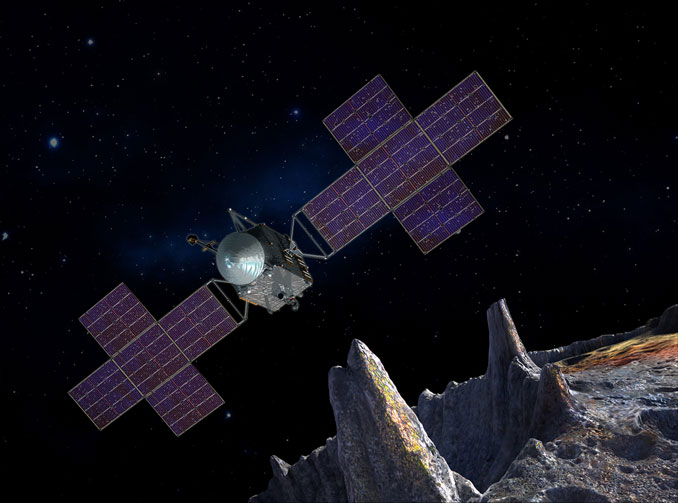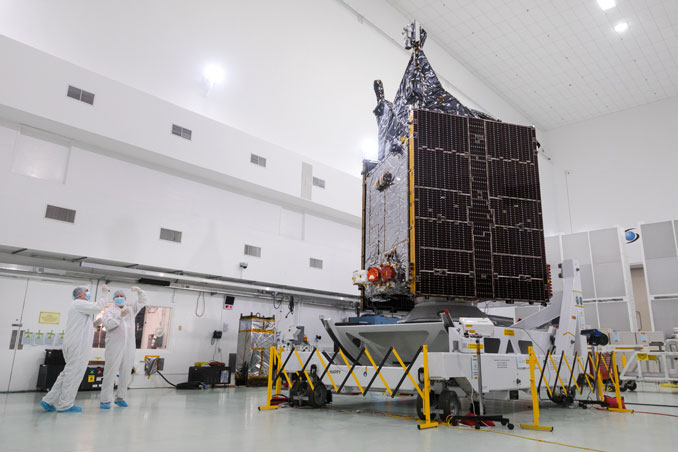Space News & Blog Articles
Simple settings tweak should save Psyche asteroid mission from overheating thrusters
 An artist’s conception of the Psyche spacecraft orbiting near the surface of the Psyche asteroid. Image: Maxar/ASU/Peter Rubin.
An artist’s conception of the Psyche spacecraft orbiting near the surface of the Psyche asteroid. Image: Maxar/ASU/Peter Rubin.
NASA’s Psyche spacecraft, now scheduled for launch on Oct. 12, will dial down the power of its maneuvering system after engineers discovered its thrusters were in danger of overheating during its eight-year expedition to explore a metallic asteroid.
The $1.2 billion mission was just two weeks from the opening of its launch window when testing of a spare thruster in a ground test bed revealed higher than expected temperatures. At first, engineers based at NASA’s Jet Propulsion Laboratory (JPL) suspected it was an isolated problem with the test bed equipment, but it soon became clear the thrusters installed on Psyche were also affected.
“The data that had come from the subcontractor about these cold gas thrusters was incorrect,” said Lindy Elkins-Tanton, Psyche’s Principal Investigator. The way the spacecraft was designed to operate was based on those specifications.
It was potentially another major blow for a project already delayed a year by late software, that had also faced challenges developing and building a spacecraft during the COVID-19 pandemic.
When thruster problem was discovered, the Psyche spacecraft was nearing the end of pre-launch preparations at the AstroTech processing facility in Titusville, Florida, near Kennedy Space Center. If any hardware changes were required, the mission could have missed its 20-day launch window and faced another long delay or even cancellation.
“It did pass through my mind: can we not catch a break?” said Elkins-Tanton.
But it was quickly determined that the overheating could be avoided by a relatively simple change to one of the parameters governing the thrusters. Instead of operating at the planned 80 percent of their maximum rated thrust, they would be limited to 30 percent.
“Thank god we’ve got this great team,” said Elkins-Tanton. “I have really transisted to a place of total gratitude that they found this before we launched. And it was just fortuitous.”
If engineers had not caught the problem, the higher than expected temperatures could have damaged the thrusters.
“It could have had a real mission impact,” said Elkins-Tanton.
 The Psyche spacecraft pictured in the clean room during pre-launch preparations. Image: Adam Bernstein/Spaceflight Now.
The Psyche spacecraft pictured in the clean room during pre-launch preparations. Image: Adam Bernstein/Spaceflight Now.
Psyche’s 12 thrusters use pulses of nitrogen to turn and orient the spacecraft. These so-called cold gas thrusters are a separate system from the xenon-fueled ion engines that will propel the spacecraft on its journey to the asteroid belt.
Operating at the lower thrust level will mean the spacecraft will turn at a slower rate, such as when it manuevers to point its antenna at Earth or to focus its science instruments on the asteroid. The mission team has been running simulations and tests to ensure the fix does not have any unintended consequences. NASA delayed the launch of Psyche by a week to complete the testing.
“We’ve been working 24/7 and it looks like it’s all going to work,” said Elkins-Tanton. “At the moment, all the tests that we’ve run — continuous, thousands of tests — have shown we’re okay at 30 percent.”
Once all the testing and validation is completed, the revised thrust setting will be included in an already planned pre-launch update of the mission’s parameters.
If all goes according well, Psyche will be encapsulated inside the two halves of its 43-foot-tall (13.1 meter) payload fairing on Tuesday, Oct. 3. It will be moved to launch complex 39A at the Kennedy Space Center and attached to its SpaceX Falcon Heavy rocket on Monday, Oct. 9.
Liftoff is scheduled for Thursday, Oct. 12 at 10:16 a.m. EDT (1416 UTC). The mission has a launch opportunity every day up to and including Oct. 25, after which its 2023 launch window closes.
The Psyche mission will be the firs to explore a rare metallic asteroid, thought to be the remnants of a protoplanet that was stripped to its core by a giant impact. The asteroid, officially titled 16 Psyche, is irregular in shape, with an average diameter of about 140 miles (226 kilometers), and is made up of mostly of nickel and iron metals. It resides in the outer part of the asteroid belt, which lies between the orbits of Mars and Jupiter. The probe will spend 26 months orbiting the asteroid after arriving in the summer of 2029.
When you subscribe to the SpaceZE News Feed, we will send you an e-mail when there are new updates on the site so you wouldn't miss them.

